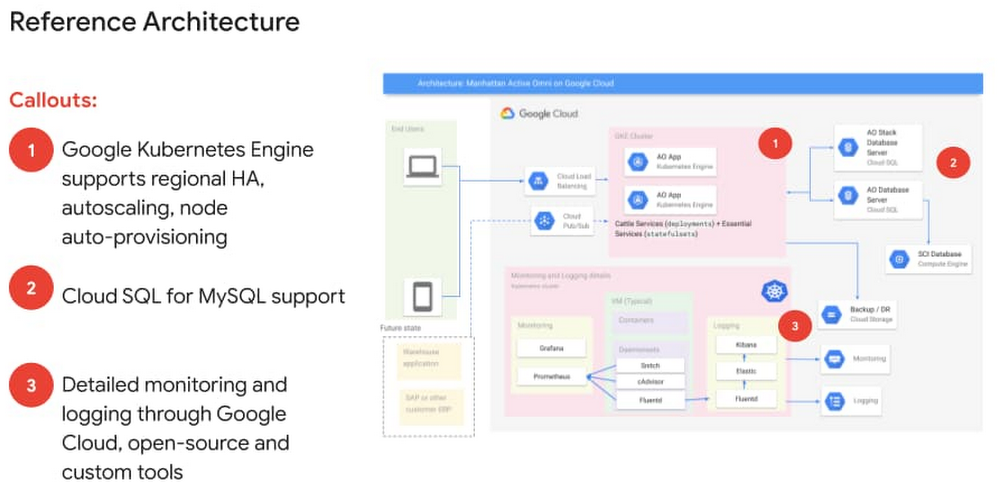As Google Cloud CEO Thomas Kurian said earlier this year, digital transformation in the retail industry is more than just a requirement, it’s a race, and the retailers that transform the fastest will be the most successful in the long term. COVID-19’s impact on the retail industry has only exacerbated this challenge, forcing retailers to rapidly marry digital and physical experiences by offering services such as curbside pickups and contactless check-out.Long before 2020, Manhattan Associates, a leader in supply chain, inventory and omnichannel e-commerce technology, recognized retailers needed a platform that could help them adapt to changing market conditions and bridge the gap from brick and mortar to digital commerce. As a result, they launched the Manhattan Active Solutions portfolio for their customers in retail, manufacturing, and distribution. Solutions like Manhattan Active Warehouse Management, the cloud-native version of their flagship warehouse management system, and Manhattan Active Omni, a suite of cloud-based inventory management, point-of-sale, and customer engagement tools, are versionless so customers get continuous access to the latest features, with automated scaling for peak demand. But for Manhattan Associates to deliver their vision to make their solutions portfolio versionless, agile, scalable, and extensible, they first needed to modernize their application environment. They knew lifting and shifting a monolithic architecture to the cloud would not deliver the level of agility that they—and their end-customers—would need, so they decided to go with microservices. Consequently, they re-architected Manhattan Active Warehouse Management and Manhattan Active Omni from the ground up to take full advantage of the benefits of the cloud.Guiding principles behind Manhattan Associates cloud-native approachFirst, Manhattan Associates established some critical architectural principles to serve as their north star for cloud-native application design. These guiding principles, as outlined below, were created to help ensure Manhattan Associates solutions could deliver the engineering velocity demanded by their end-customers while also aiming to reduce the cost of innovation.Speed of innovation: Manhattan Associates strove to adopt a microservices-based, cloud-native approach so they could deliver new functionality faster than their competitors, and faster than they themselves had previously done. Extensibility: In addition to accelerating innovation in house, they also sought to ensure an open and extensible ecosystem so that their customers and partners can easily build and integrate additional capabilities without dependence on Manhattan Associates.Flexibility: With these managed SaaS versions of their flagship products, Manhattan Associates needed the flexibility to scale performance and resources based on their end-customers’ needs.Low cost of innovation: Finally, Manhattan Associates required the ability to leverage open-source technologies for portability and to avoid vendor lock-in. In addition, they required detailed logging and monitoring tools in order to maintain control over costs.Partnering with Google Cloud to meet business objectivesIn order to deliver on the imperatives outlined above, Manhattan Associates teamed with Google Cloud as their cloud platform. Here’s a quick look at how they are leveraging key Google Cloud services to help meet the objectives laid out in their guiding principles.Achieving agility, scalability, and resiliency with Google Kubernetes Engine: Manhattan Associates built on top of their already extensive Kubernetes experience and took advantage of Google Kubernetes Engine managed features such as regional high availability, autoscaling, node auto-provisioning, and the auto-repair functionality to help ensure scalability and resiliency for their containerized workloads.Gaining ease of use and openness with Cloud SQL for MySQL: Manhattan Associates team members were also long-time users of MySQL. With Cloud SQL for MySQL, they were able to continue using open-source software to run managed MySQL databases. In addition, Manhattan Associates could leverage Cloud SQL to support their environment setup and their customer needs. For instance, they can create a Cloud SQL database instance per project. And each project can correspond with an environment, like dev/test and production or with a specific customer. They also have the flexibility to support optional add-ons for each customer like additional database instances for high availability.Visibility and control with detailed monitoring and logging: Finally, Manhattan Associates demanded very detailed monitoring and logging to help ensure customer environments were running effectively across the stack. They leveraged a combination of open-source, custom and Google Cloud tools like Cloud Logging, Cloud Monitoring, and CloudRun as well as in-house tools to keep tabs on their environments and trigger alerts so that Manhattan Associates teams can take action when needed.As a result, Manhattan Associates was able to deliver a truly cloud-native warehouse management and unified commerce platform, built using microservices. They have been delivering on their goal of engineering velocity; releasing features quarterly versus annually as was the case on their prior monolithic architecture. More importantly, they can pass this speed of innovation on to their end-customers.To learn more about how Manhattan Associates rebuilt their platform in the cloud, check out the Manhattan Active Warehouse Management andManhattan Active Omni on Google Cloud virtual breakout sessions at Manhattan Associates’ digital event, Momentum Connect. In these sessions, they’ll dive into more detail behind their cloud native approach, their use cases, and how they combined Google Cloud, open-source, and home-grown tools to bring their Manhattan Active Warehouse Management and Manhattan Active Omni solutions to market.
Quelle: Google Cloud Platform

Published by